RESPIRATORY SYSTEM CASE STUDY 2022
VerifiedAdded on 2022/08/26
|10
|2709
|12
AI Summary
Contribute Materials
Your contribution can guide someone’s learning journey. Share your
documents today.
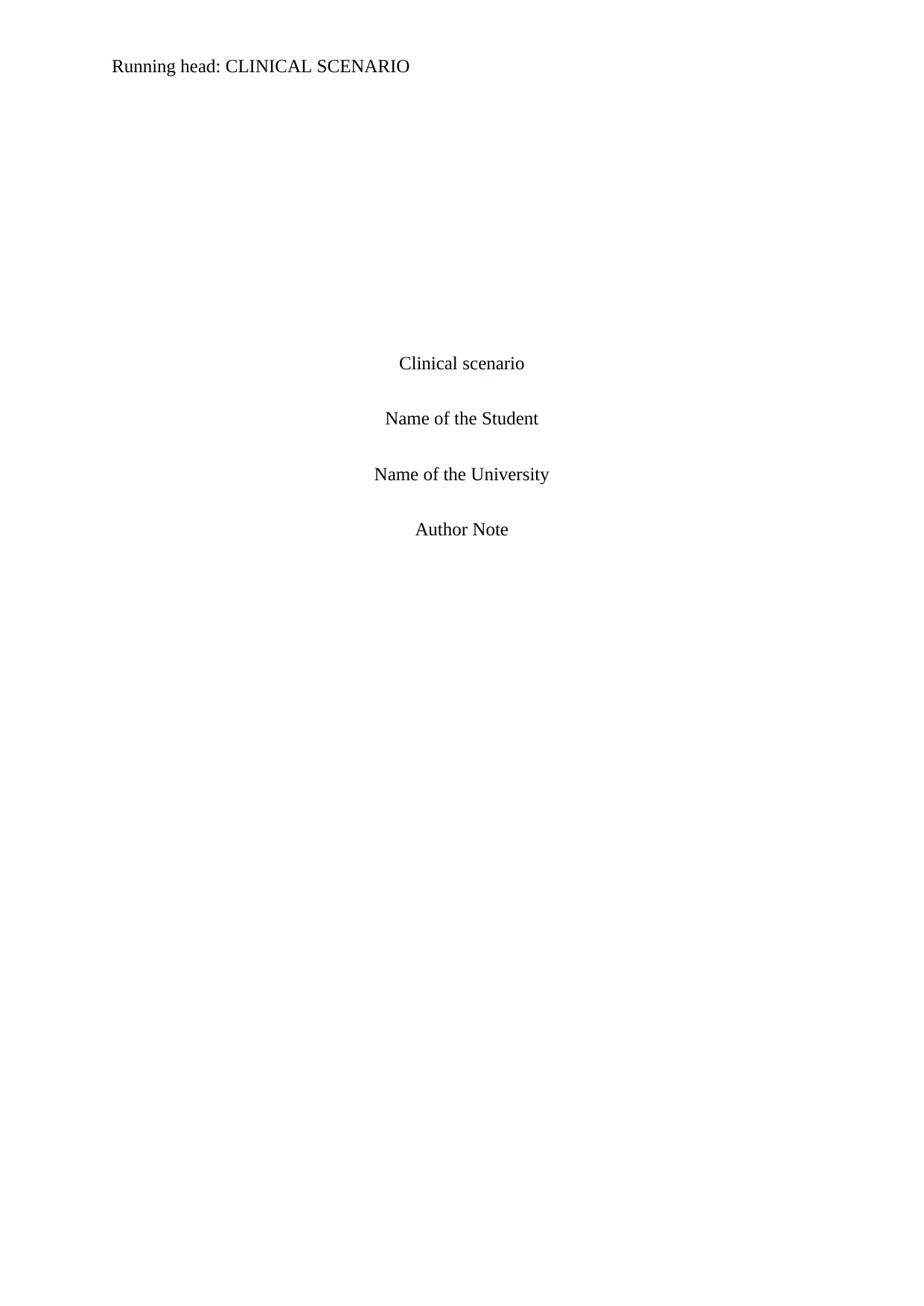
Running head: CLINICAL SCENARIO
Clinical scenario
Name of the Student
Name of the University
Author Note
Clinical scenario
Name of the Student
Name of the University
Author Note
Secure Best Marks with AI Grader
Need help grading? Try our AI Grader for instant feedback on your assignments.
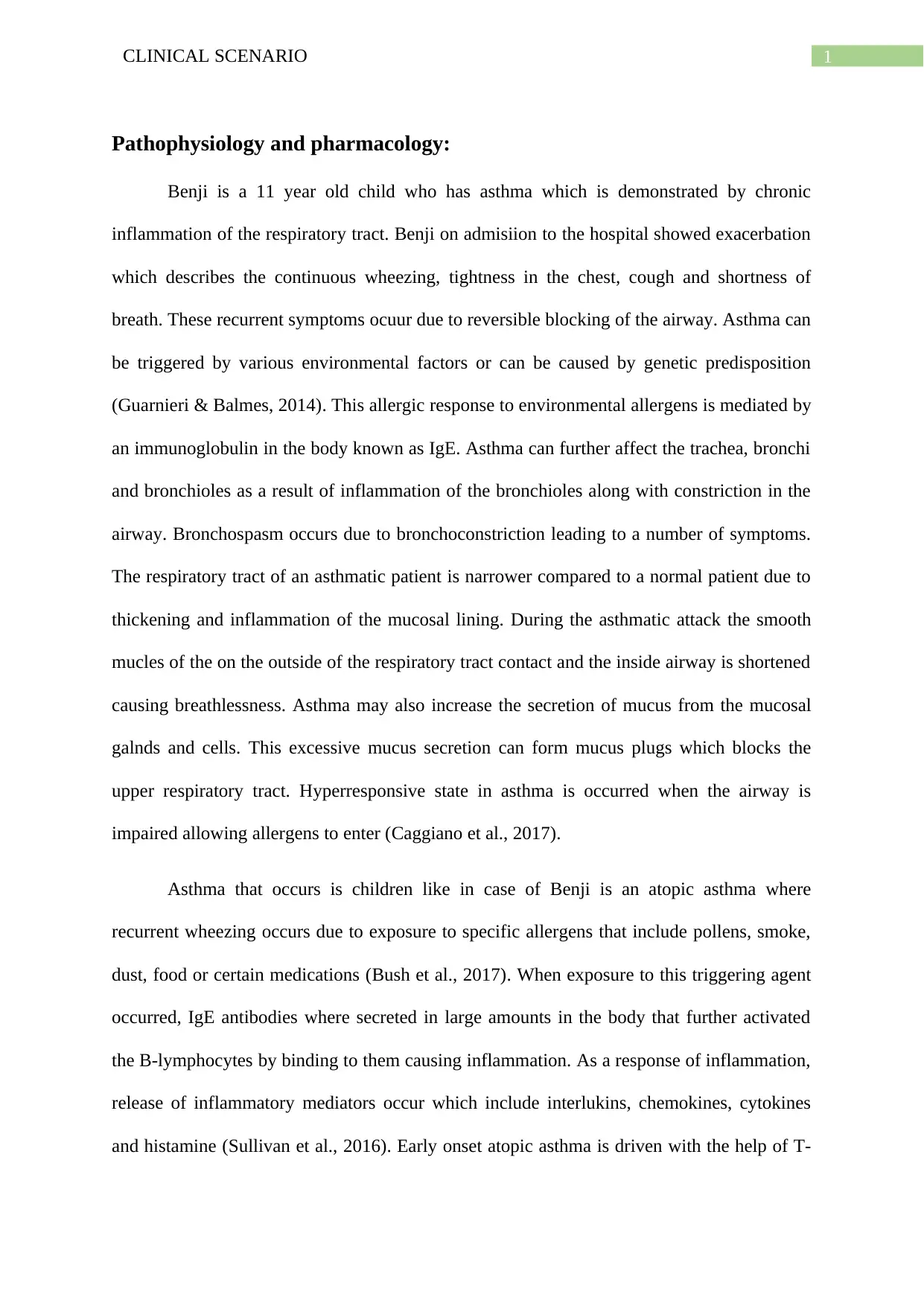
1CLINICAL SCENARIO
Pathophysiology and pharmacology:
Benji is a 11 year old child who has asthma which is demonstrated by chronic
inflammation of the respiratory tract. Benji on admisiion to the hospital showed exacerbation
which describes the continuous wheezing, tightness in the chest, cough and shortness of
breath. These recurrent symptoms ocuur due to reversible blocking of the airway. Asthma can
be triggered by various environmental factors or can be caused by genetic predisposition
(Guarnieri & Balmes, 2014). This allergic response to environmental allergens is mediated by
an immunoglobulin in the body known as IgE. Asthma can further affect the trachea, bronchi
and bronchioles as a result of inflammation of the bronchioles along with constriction in the
airway. Bronchospasm occurs due to bronchoconstriction leading to a number of symptoms.
The respiratory tract of an asthmatic patient is narrower compared to a normal patient due to
thickening and inflammation of the mucosal lining. During the asthmatic attack the smooth
mucles of the on the outside of the respiratory tract contact and the inside airway is shortened
causing breathlessness. Asthma may also increase the secretion of mucus from the mucosal
galnds and cells. This excessive mucus secretion can form mucus plugs which blocks the
upper respiratory tract. Hyperresponsive state in asthma is occurred when the airway is
impaired allowing allergens to enter (Caggiano et al., 2017).
Asthma that occurs is children like in case of Benji is an atopic asthma where
recurrent wheezing occurs due to exposure to specific allergens that include pollens, smoke,
dust, food or certain medications (Bush et al., 2017). When exposure to this triggering agent
occurred, IgE antibodies where secreted in large amounts in the body that further activated
the B-lymphocytes by binding to them causing inflammation. As a response of inflammation,
release of inflammatory mediators occur which include interlukins, chemokines, cytokines
and histamine (Sullivan et al., 2016). Early onset atopic asthma is driven with the help of T-
Pathophysiology and pharmacology:
Benji is a 11 year old child who has asthma which is demonstrated by chronic
inflammation of the respiratory tract. Benji on admisiion to the hospital showed exacerbation
which describes the continuous wheezing, tightness in the chest, cough and shortness of
breath. These recurrent symptoms ocuur due to reversible blocking of the airway. Asthma can
be triggered by various environmental factors or can be caused by genetic predisposition
(Guarnieri & Balmes, 2014). This allergic response to environmental allergens is mediated by
an immunoglobulin in the body known as IgE. Asthma can further affect the trachea, bronchi
and bronchioles as a result of inflammation of the bronchioles along with constriction in the
airway. Bronchospasm occurs due to bronchoconstriction leading to a number of symptoms.
The respiratory tract of an asthmatic patient is narrower compared to a normal patient due to
thickening and inflammation of the mucosal lining. During the asthmatic attack the smooth
mucles of the on the outside of the respiratory tract contact and the inside airway is shortened
causing breathlessness. Asthma may also increase the secretion of mucus from the mucosal
galnds and cells. This excessive mucus secretion can form mucus plugs which blocks the
upper respiratory tract. Hyperresponsive state in asthma is occurred when the airway is
impaired allowing allergens to enter (Caggiano et al., 2017).
Asthma that occurs is children like in case of Benji is an atopic asthma where
recurrent wheezing occurs due to exposure to specific allergens that include pollens, smoke,
dust, food or certain medications (Bush et al., 2017). When exposure to this triggering agent
occurred, IgE antibodies where secreted in large amounts in the body that further activated
the B-lymphocytes by binding to them causing inflammation. As a response of inflammation,
release of inflammatory mediators occur which include interlukins, chemokines, cytokines
and histamine (Sullivan et al., 2016). Early onset atopic asthma is driven with the help of T-
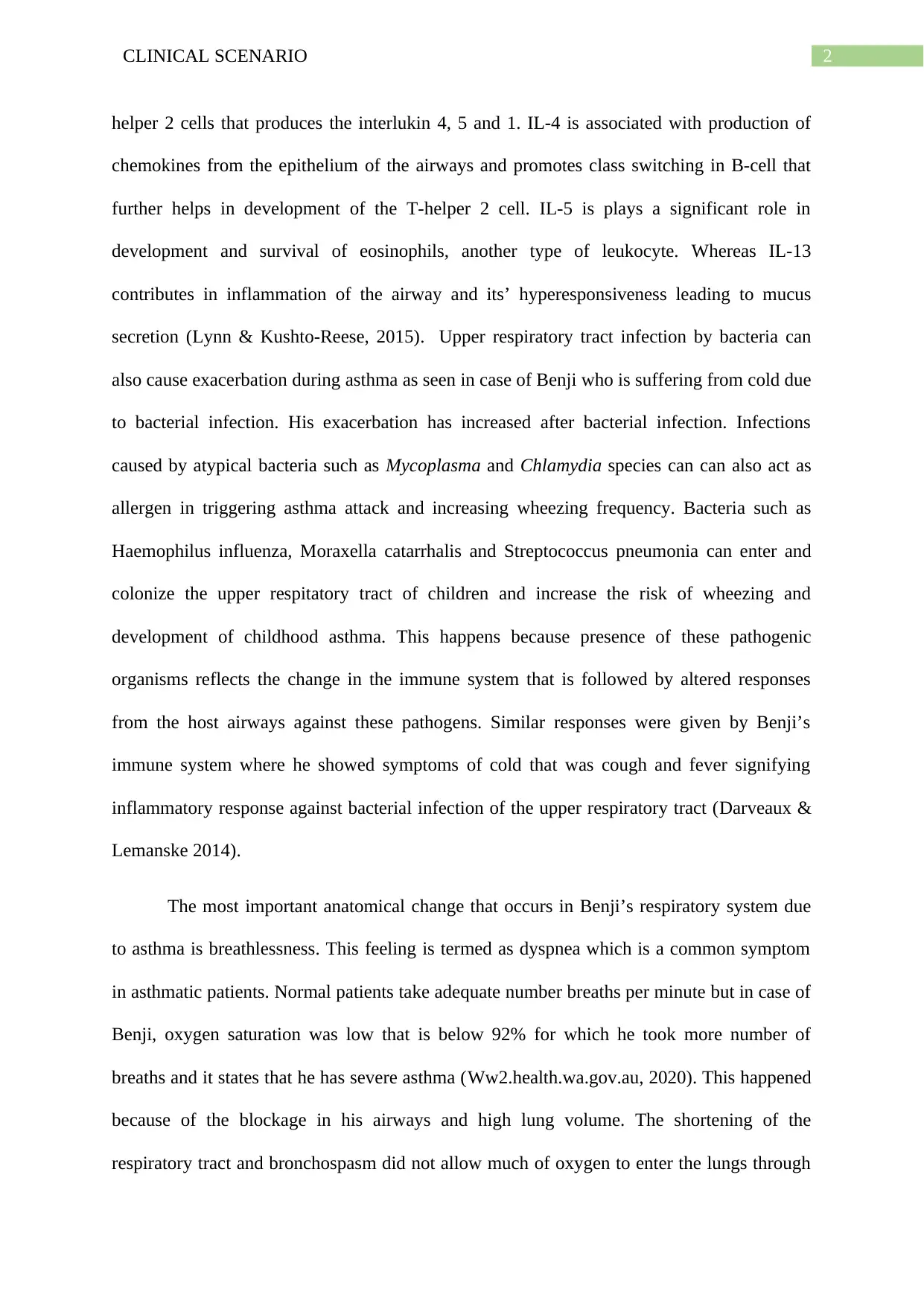
2CLINICAL SCENARIO
helper 2 cells that produces the interlukin 4, 5 and 1. IL-4 is associated with production of
chemokines from the epithelium of the airways and promotes class switching in B-cell that
further helps in development of the T-helper 2 cell. IL-5 is plays a significant role in
development and survival of eosinophils, another type of leukocyte. Whereas IL-13
contributes in inflammation of the airway and its’ hyperesponsiveness leading to mucus
secretion (Lynn & Kushto-Reese, 2015). Upper respiratory tract infection by bacteria can
also cause exacerbation during asthma as seen in case of Benji who is suffering from cold due
to bacterial infection. His exacerbation has increased after bacterial infection. Infections
caused by atypical bacteria such as Mycoplasma and Chlamydia species can can also act as
allergen in triggering asthma attack and increasing wheezing frequency. Bacteria such as
Haemophilus influenza, Moraxella catarrhalis and Streptococcus pneumonia can enter and
colonize the upper respitatory tract of children and increase the risk of wheezing and
development of childhood asthma. This happens because presence of these pathogenic
organisms reflects the change in the immune system that is followed by altered responses
from the host airways against these pathogens. Similar responses were given by Benji’s
immune system where he showed symptoms of cold that was cough and fever signifying
inflammatory response against bacterial infection of the upper respiratory tract (Darveaux &
Lemanske 2014).
The most important anatomical change that occurs in Benji’s respiratory system due
to asthma is breathlessness. This feeling is termed as dyspnea which is a common symptom
in asthmatic patients. Normal patients take adequate number breaths per minute but in case of
Benji, oxygen saturation was low that is below 92% for which he took more number of
breaths and it states that he has severe asthma (Ww2.health.wa.gov.au, 2020). This happened
because of the blockage in his airways and high lung volume. The shortening of the
respiratory tract and bronchospasm did not allow much of oxygen to enter the lungs through
helper 2 cells that produces the interlukin 4, 5 and 1. IL-4 is associated with production of
chemokines from the epithelium of the airways and promotes class switching in B-cell that
further helps in development of the T-helper 2 cell. IL-5 is plays a significant role in
development and survival of eosinophils, another type of leukocyte. Whereas IL-13
contributes in inflammation of the airway and its’ hyperesponsiveness leading to mucus
secretion (Lynn & Kushto-Reese, 2015). Upper respiratory tract infection by bacteria can
also cause exacerbation during asthma as seen in case of Benji who is suffering from cold due
to bacterial infection. His exacerbation has increased after bacterial infection. Infections
caused by atypical bacteria such as Mycoplasma and Chlamydia species can can also act as
allergen in triggering asthma attack and increasing wheezing frequency. Bacteria such as
Haemophilus influenza, Moraxella catarrhalis and Streptococcus pneumonia can enter and
colonize the upper respitatory tract of children and increase the risk of wheezing and
development of childhood asthma. This happens because presence of these pathogenic
organisms reflects the change in the immune system that is followed by altered responses
from the host airways against these pathogens. Similar responses were given by Benji’s
immune system where he showed symptoms of cold that was cough and fever signifying
inflammatory response against bacterial infection of the upper respiratory tract (Darveaux &
Lemanske 2014).
The most important anatomical change that occurs in Benji’s respiratory system due
to asthma is breathlessness. This feeling is termed as dyspnea which is a common symptom
in asthmatic patients. Normal patients take adequate number breaths per minute but in case of
Benji, oxygen saturation was low that is below 92% for which he took more number of
breaths and it states that he has severe asthma (Ww2.health.wa.gov.au, 2020). This happened
because of the blockage in his airways and high lung volume. The shortening of the
respiratory tract and bronchospasm did not allow much of oxygen to enter the lungs through
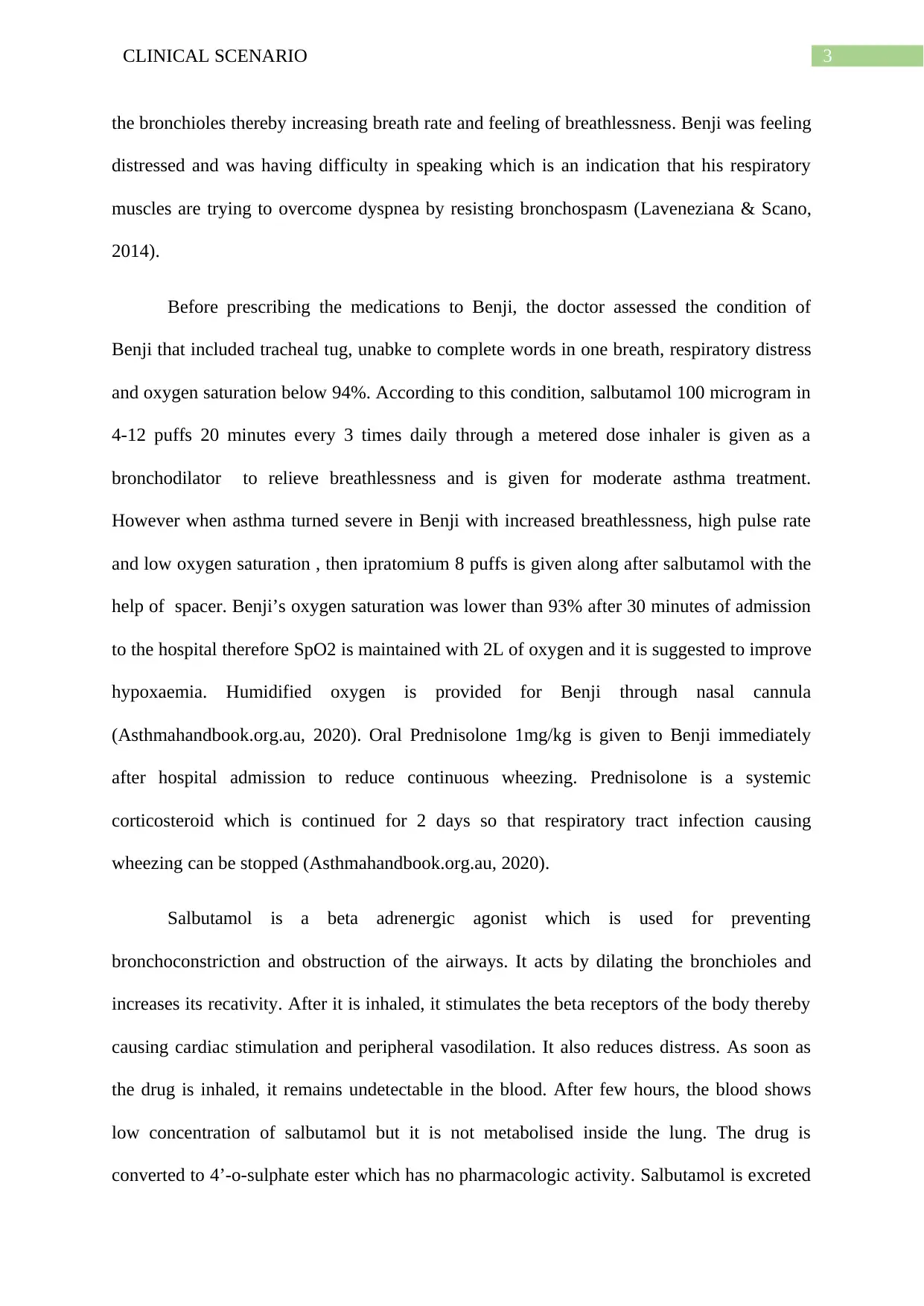
3CLINICAL SCENARIO
the bronchioles thereby increasing breath rate and feeling of breathlessness. Benji was feeling
distressed and was having difficulty in speaking which is an indication that his respiratory
muscles are trying to overcome dyspnea by resisting bronchospasm (Laveneziana & Scano,
2014).
Before prescribing the medications to Benji, the doctor assessed the condition of
Benji that included tracheal tug, unabke to complete words in one breath, respiratory distress
and oxygen saturation below 94%. According to this condition, salbutamol 100 microgram in
4-12 puffs 20 minutes every 3 times daily through a metered dose inhaler is given as a
bronchodilator to relieve breathlessness and is given for moderate asthma treatment.
However when asthma turned severe in Benji with increased breathlessness, high pulse rate
and low oxygen saturation , then ipratomium 8 puffs is given along after salbutamol with the
help of spacer. Benji’s oxygen saturation was lower than 93% after 30 minutes of admission
to the hospital therefore SpO2 is maintained with 2L of oxygen and it is suggested to improve
hypoxaemia. Humidified oxygen is provided for Benji through nasal cannula
(Asthmahandbook.org.au, 2020). Oral Prednisolone 1mg/kg is given to Benji immediately
after hospital admission to reduce continuous wheezing. Prednisolone is a systemic
corticosteroid which is continued for 2 days so that respiratory tract infection causing
wheezing can be stopped (Asthmahandbook.org.au, 2020).
Salbutamol is a beta adrenergic agonist which is used for preventing
bronchoconstriction and obstruction of the airways. It acts by dilating the bronchioles and
increases its recativity. After it is inhaled, it stimulates the beta receptors of the body thereby
causing cardiac stimulation and peripheral vasodilation. It also reduces distress. As soon as
the drug is inhaled, it remains undetectable in the blood. After few hours, the blood shows
low concentration of salbutamol but it is not metabolised inside the lung. The drug is
converted to 4’-o-sulphate ester which has no pharmacologic activity. Salbutamol is excreted
the bronchioles thereby increasing breath rate and feeling of breathlessness. Benji was feeling
distressed and was having difficulty in speaking which is an indication that his respiratory
muscles are trying to overcome dyspnea by resisting bronchospasm (Laveneziana & Scano,
2014).
Before prescribing the medications to Benji, the doctor assessed the condition of
Benji that included tracheal tug, unabke to complete words in one breath, respiratory distress
and oxygen saturation below 94%. According to this condition, salbutamol 100 microgram in
4-12 puffs 20 minutes every 3 times daily through a metered dose inhaler is given as a
bronchodilator to relieve breathlessness and is given for moderate asthma treatment.
However when asthma turned severe in Benji with increased breathlessness, high pulse rate
and low oxygen saturation , then ipratomium 8 puffs is given along after salbutamol with the
help of spacer. Benji’s oxygen saturation was lower than 93% after 30 minutes of admission
to the hospital therefore SpO2 is maintained with 2L of oxygen and it is suggested to improve
hypoxaemia. Humidified oxygen is provided for Benji through nasal cannula
(Asthmahandbook.org.au, 2020). Oral Prednisolone 1mg/kg is given to Benji immediately
after hospital admission to reduce continuous wheezing. Prednisolone is a systemic
corticosteroid which is continued for 2 days so that respiratory tract infection causing
wheezing can be stopped (Asthmahandbook.org.au, 2020).
Salbutamol is a beta adrenergic agonist which is used for preventing
bronchoconstriction and obstruction of the airways. It acts by dilating the bronchioles and
increases its recativity. After it is inhaled, it stimulates the beta receptors of the body thereby
causing cardiac stimulation and peripheral vasodilation. It also reduces distress. As soon as
the drug is inhaled, it remains undetectable in the blood. After few hours, the blood shows
low concentration of salbutamol but it is not metabolised inside the lung. The drug is
converted to 4’-o-sulphate ester which has no pharmacologic activity. Salbutamol is excreted
Secure Best Marks with AI Grader
Need help grading? Try our AI Grader for instant feedback on your assignments.
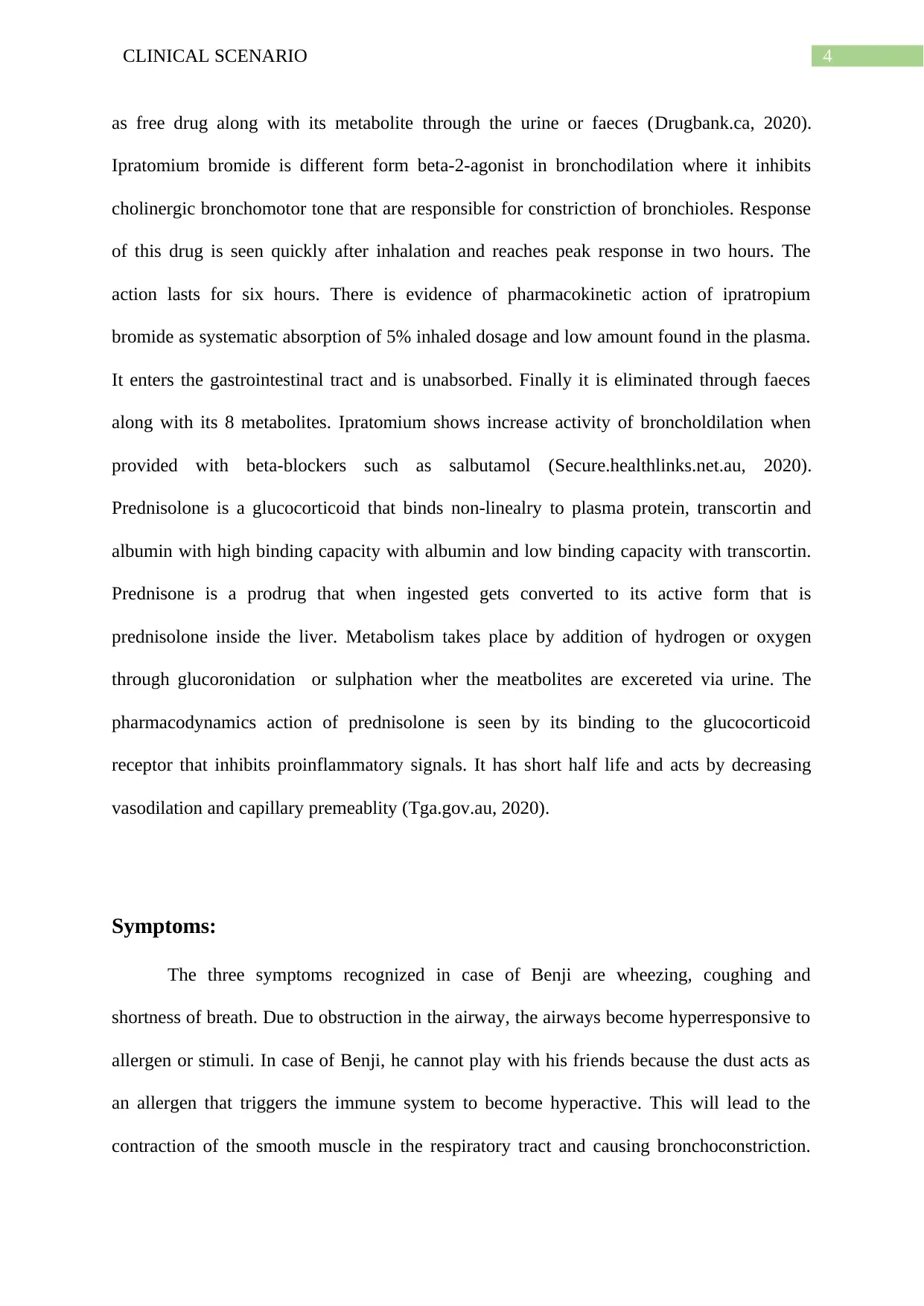
4CLINICAL SCENARIO
as free drug along with its metabolite through the urine or faeces (Drugbank.ca, 2020).
Ipratomium bromide is different form beta-2-agonist in bronchodilation where it inhibits
cholinergic bronchomotor tone that are responsible for constriction of bronchioles. Response
of this drug is seen quickly after inhalation and reaches peak response in two hours. The
action lasts for six hours. There is evidence of pharmacokinetic action of ipratropium
bromide as systematic absorption of 5% inhaled dosage and low amount found in the plasma.
It enters the gastrointestinal tract and is unabsorbed. Finally it is eliminated through faeces
along with its 8 metabolites. Ipratomium shows increase activity of broncholdilation when
provided with beta-blockers such as salbutamol (Secure.healthlinks.net.au, 2020).
Prednisolone is a glucocorticoid that binds non-linealry to plasma protein, transcortin and
albumin with high binding capacity with albumin and low binding capacity with transcortin.
Prednisone is a prodrug that when ingested gets converted to its active form that is
prednisolone inside the liver. Metabolism takes place by addition of hydrogen or oxygen
through glucoronidation or sulphation wher the meatbolites are excereted via urine. The
pharmacodynamics action of prednisolone is seen by its binding to the glucocorticoid
receptor that inhibits proinflammatory signals. It has short half life and acts by decreasing
vasodilation and capillary premeablity (Tga.gov.au, 2020).
Symptoms:
The three symptoms recognized in case of Benji are wheezing, coughing and
shortness of breath. Due to obstruction in the airway, the airways become hyperresponsive to
allergen or stimuli. In case of Benji, he cannot play with his friends because the dust acts as
an allergen that triggers the immune system to become hyperactive. This will lead to the
contraction of the smooth muscle in the respiratory tract and causing bronchoconstriction.
as free drug along with its metabolite through the urine or faeces (Drugbank.ca, 2020).
Ipratomium bromide is different form beta-2-agonist in bronchodilation where it inhibits
cholinergic bronchomotor tone that are responsible for constriction of bronchioles. Response
of this drug is seen quickly after inhalation and reaches peak response in two hours. The
action lasts for six hours. There is evidence of pharmacokinetic action of ipratropium
bromide as systematic absorption of 5% inhaled dosage and low amount found in the plasma.
It enters the gastrointestinal tract and is unabsorbed. Finally it is eliminated through faeces
along with its 8 metabolites. Ipratomium shows increase activity of broncholdilation when
provided with beta-blockers such as salbutamol (Secure.healthlinks.net.au, 2020).
Prednisolone is a glucocorticoid that binds non-linealry to plasma protein, transcortin and
albumin with high binding capacity with albumin and low binding capacity with transcortin.
Prednisone is a prodrug that when ingested gets converted to its active form that is
prednisolone inside the liver. Metabolism takes place by addition of hydrogen or oxygen
through glucoronidation or sulphation wher the meatbolites are excereted via urine. The
pharmacodynamics action of prednisolone is seen by its binding to the glucocorticoid
receptor that inhibits proinflammatory signals. It has short half life and acts by decreasing
vasodilation and capillary premeablity (Tga.gov.au, 2020).
Symptoms:
The three symptoms recognized in case of Benji are wheezing, coughing and
shortness of breath. Due to obstruction in the airway, the airways become hyperresponsive to
allergen or stimuli. In case of Benji, he cannot play with his friends because the dust acts as
an allergen that triggers the immune system to become hyperactive. This will lead to the
contraction of the smooth muscle in the respiratory tract and causing bronchoconstriction.
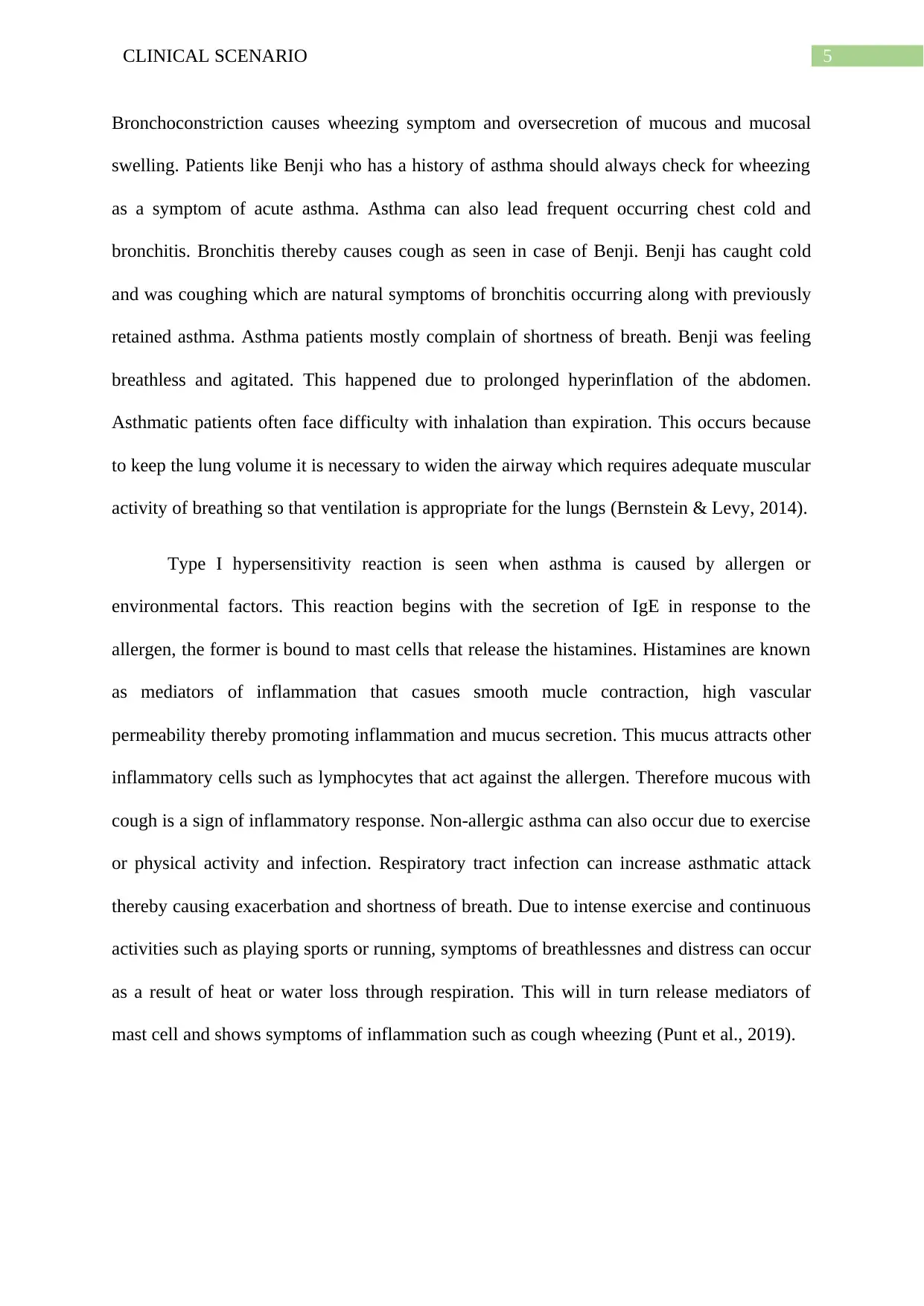
5CLINICAL SCENARIO
Bronchoconstriction causes wheezing symptom and oversecretion of mucous and mucosal
swelling. Patients like Benji who has a history of asthma should always check for wheezing
as a symptom of acute asthma. Asthma can also lead frequent occurring chest cold and
bronchitis. Bronchitis thereby causes cough as seen in case of Benji. Benji has caught cold
and was coughing which are natural symptoms of bronchitis occurring along with previously
retained asthma. Asthma patients mostly complain of shortness of breath. Benji was feeling
breathless and agitated. This happened due to prolonged hyperinflation of the abdomen.
Asthmatic patients often face difficulty with inhalation than expiration. This occurs because
to keep the lung volume it is necessary to widen the airway which requires adequate muscular
activity of breathing so that ventilation is appropriate for the lungs (Bernstein & Levy, 2014).
Type I hypersensitivity reaction is seen when asthma is caused by allergen or
environmental factors. This reaction begins with the secretion of IgE in response to the
allergen, the former is bound to mast cells that release the histamines. Histamines are known
as mediators of inflammation that casues smooth mucle contraction, high vascular
permeability thereby promoting inflammation and mucus secretion. This mucus attracts other
inflammatory cells such as lymphocytes that act against the allergen. Therefore mucous with
cough is a sign of inflammatory response. Non-allergic asthma can also occur due to exercise
or physical activity and infection. Respiratory tract infection can increase asthmatic attack
thereby causing exacerbation and shortness of breath. Due to intense exercise and continuous
activities such as playing sports or running, symptoms of breathlessnes and distress can occur
as a result of heat or water loss through respiration. This will in turn release mediators of
mast cell and shows symptoms of inflammation such as cough wheezing (Punt et al., 2019).
Bronchoconstriction causes wheezing symptom and oversecretion of mucous and mucosal
swelling. Patients like Benji who has a history of asthma should always check for wheezing
as a symptom of acute asthma. Asthma can also lead frequent occurring chest cold and
bronchitis. Bronchitis thereby causes cough as seen in case of Benji. Benji has caught cold
and was coughing which are natural symptoms of bronchitis occurring along with previously
retained asthma. Asthma patients mostly complain of shortness of breath. Benji was feeling
breathless and agitated. This happened due to prolonged hyperinflation of the abdomen.
Asthmatic patients often face difficulty with inhalation than expiration. This occurs because
to keep the lung volume it is necessary to widen the airway which requires adequate muscular
activity of breathing so that ventilation is appropriate for the lungs (Bernstein & Levy, 2014).
Type I hypersensitivity reaction is seen when asthma is caused by allergen or
environmental factors. This reaction begins with the secretion of IgE in response to the
allergen, the former is bound to mast cells that release the histamines. Histamines are known
as mediators of inflammation that casues smooth mucle contraction, high vascular
permeability thereby promoting inflammation and mucus secretion. This mucus attracts other
inflammatory cells such as lymphocytes that act against the allergen. Therefore mucous with
cough is a sign of inflammatory response. Non-allergic asthma can also occur due to exercise
or physical activity and infection. Respiratory tract infection can increase asthmatic attack
thereby causing exacerbation and shortness of breath. Due to intense exercise and continuous
activities such as playing sports or running, symptoms of breathlessnes and distress can occur
as a result of heat or water loss through respiration. This will in turn release mediators of
mast cell and shows symptoms of inflammation such as cough wheezing (Punt et al., 2019).
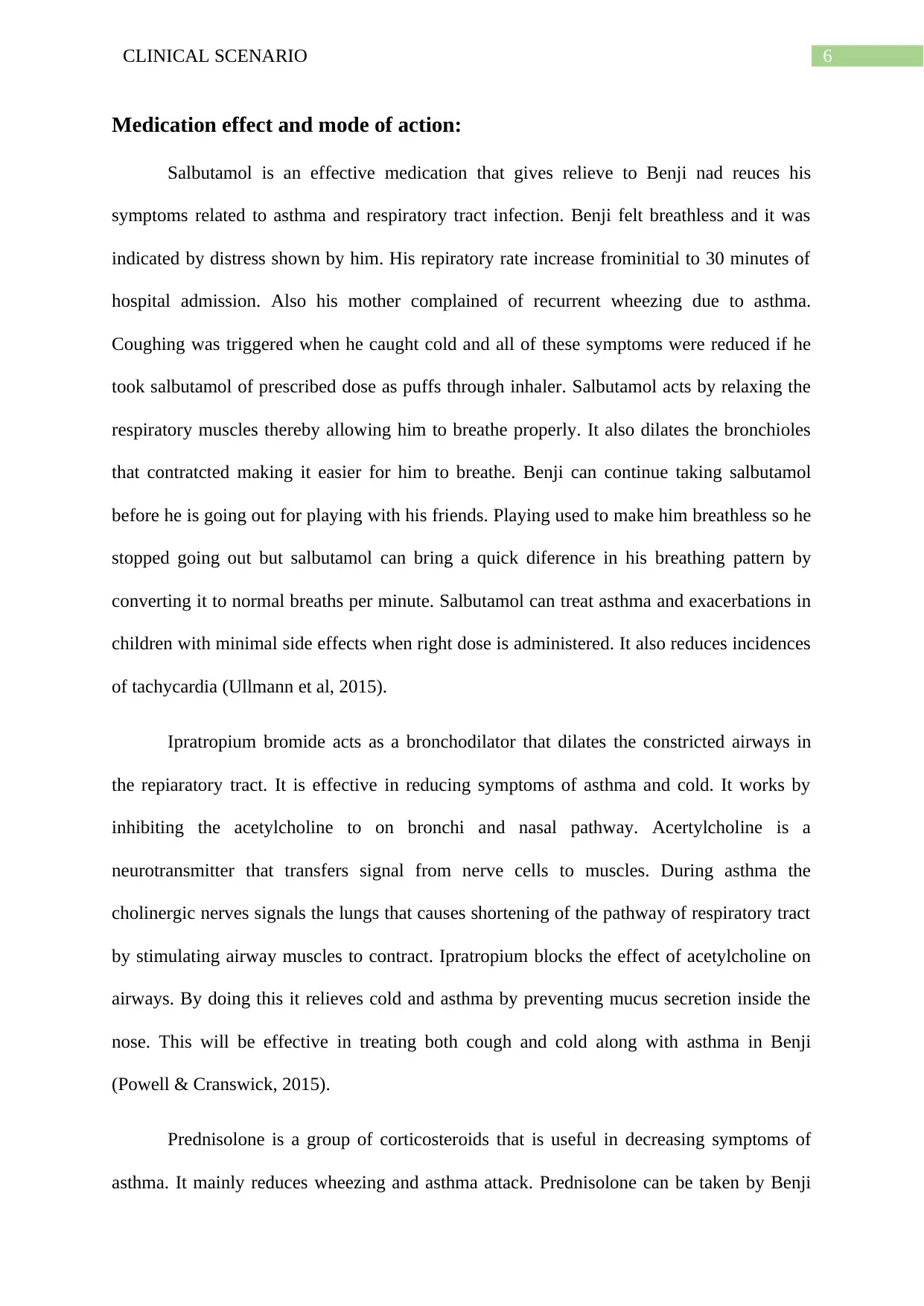
6CLINICAL SCENARIO
Medication effect and mode of action:
Salbutamol is an effective medication that gives relieve to Benji nad reuces his
symptoms related to asthma and respiratory tract infection. Benji felt breathless and it was
indicated by distress shown by him. His repiratory rate increase frominitial to 30 minutes of
hospital admission. Also his mother complained of recurrent wheezing due to asthma.
Coughing was triggered when he caught cold and all of these symptoms were reduced if he
took salbutamol of prescribed dose as puffs through inhaler. Salbutamol acts by relaxing the
respiratory muscles thereby allowing him to breathe properly. It also dilates the bronchioles
that contratcted making it easier for him to breathe. Benji can continue taking salbutamol
before he is going out for playing with his friends. Playing used to make him breathless so he
stopped going out but salbutamol can bring a quick diference in his breathing pattern by
converting it to normal breaths per minute. Salbutamol can treat asthma and exacerbations in
children with minimal side effects when right dose is administered. It also reduces incidences
of tachycardia (Ullmann et al, 2015).
Ipratropium bromide acts as a bronchodilator that dilates the constricted airways in
the repiaratory tract. It is effective in reducing symptoms of asthma and cold. It works by
inhibiting the acetylcholine to on bronchi and nasal pathway. Acertylcholine is a
neurotransmitter that transfers signal from nerve cells to muscles. During asthma the
cholinergic nerves signals the lungs that causes shortening of the pathway of respiratory tract
by stimulating airway muscles to contract. Ipratropium blocks the effect of acetylcholine on
airways. By doing this it relieves cold and asthma by preventing mucus secretion inside the
nose. This will be effective in treating both cough and cold along with asthma in Benji
(Powell & Cranswick, 2015).
Prednisolone is a group of corticosteroids that is useful in decreasing symptoms of
asthma. It mainly reduces wheezing and asthma attack. Prednisolone can be taken by Benji
Medication effect and mode of action:
Salbutamol is an effective medication that gives relieve to Benji nad reuces his
symptoms related to asthma and respiratory tract infection. Benji felt breathless and it was
indicated by distress shown by him. His repiratory rate increase frominitial to 30 minutes of
hospital admission. Also his mother complained of recurrent wheezing due to asthma.
Coughing was triggered when he caught cold and all of these symptoms were reduced if he
took salbutamol of prescribed dose as puffs through inhaler. Salbutamol acts by relaxing the
respiratory muscles thereby allowing him to breathe properly. It also dilates the bronchioles
that contratcted making it easier for him to breathe. Benji can continue taking salbutamol
before he is going out for playing with his friends. Playing used to make him breathless so he
stopped going out but salbutamol can bring a quick diference in his breathing pattern by
converting it to normal breaths per minute. Salbutamol can treat asthma and exacerbations in
children with minimal side effects when right dose is administered. It also reduces incidences
of tachycardia (Ullmann et al, 2015).
Ipratropium bromide acts as a bronchodilator that dilates the constricted airways in
the repiaratory tract. It is effective in reducing symptoms of asthma and cold. It works by
inhibiting the acetylcholine to on bronchi and nasal pathway. Acertylcholine is a
neurotransmitter that transfers signal from nerve cells to muscles. During asthma the
cholinergic nerves signals the lungs that causes shortening of the pathway of respiratory tract
by stimulating airway muscles to contract. Ipratropium blocks the effect of acetylcholine on
airways. By doing this it relieves cold and asthma by preventing mucus secretion inside the
nose. This will be effective in treating both cough and cold along with asthma in Benji
(Powell & Cranswick, 2015).
Prednisolone is a group of corticosteroids that is useful in decreasing symptoms of
asthma. It mainly reduces wheezing and asthma attack. Prednisolone can be taken by Benji
Paraphrase This Document
Need a fresh take? Get an instant paraphrase of this document with our AI Paraphraser
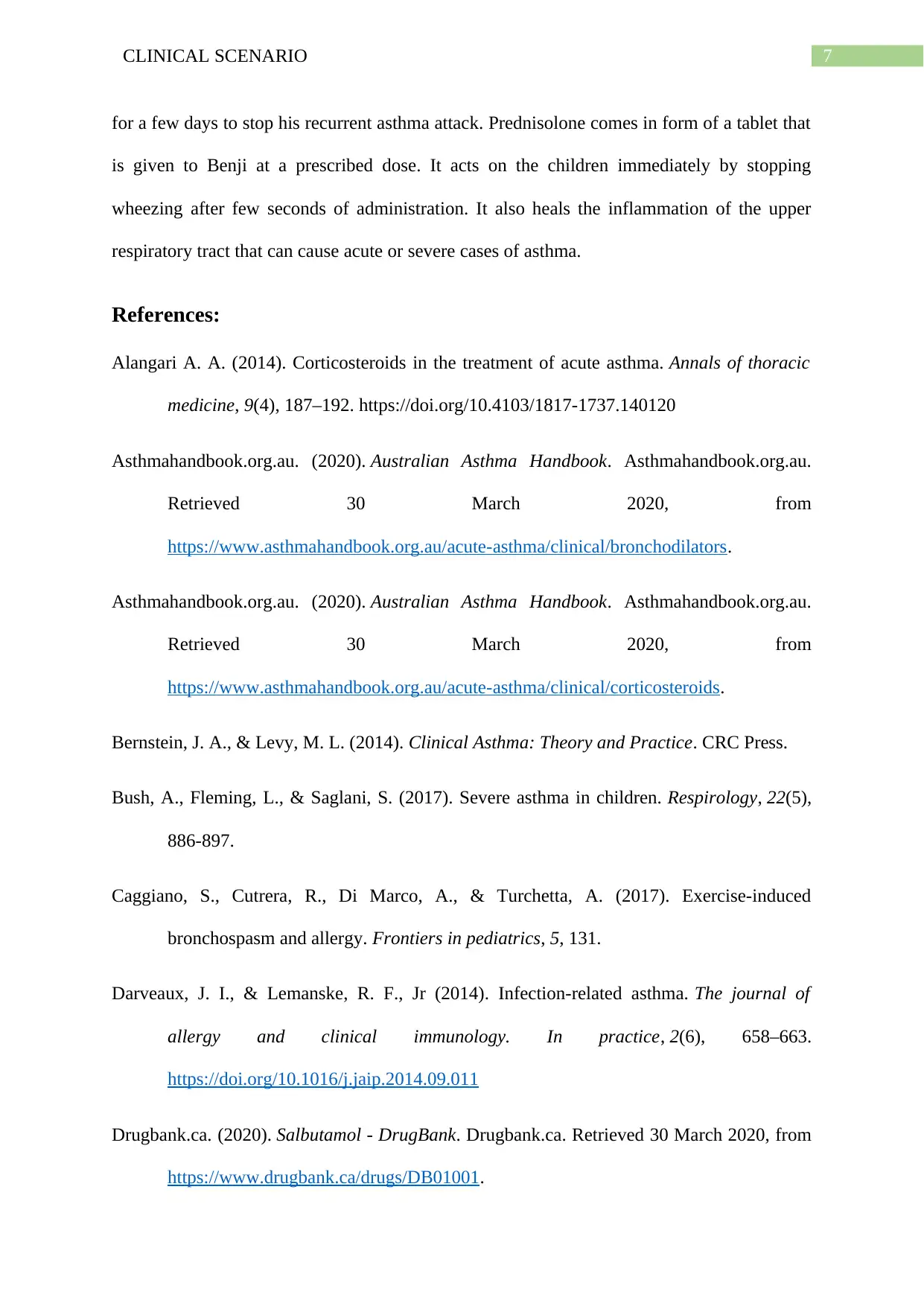
7CLINICAL SCENARIO
for a few days to stop his recurrent asthma attack. Prednisolone comes in form of a tablet that
is given to Benji at a prescribed dose. It acts on the children immediately by stopping
wheezing after few seconds of administration. It also heals the inflammation of the upper
respiratory tract that can cause acute or severe cases of asthma.
References:
Alangari A. A. (2014). Corticosteroids in the treatment of acute asthma. Annals of thoracic
medicine, 9(4), 187–192. https://doi.org/10.4103/1817-1737.140120
Asthmahandbook.org.au. (2020). Australian Asthma Handbook. Asthmahandbook.org.au.
Retrieved 30 March 2020, from
https://www.asthmahandbook.org.au/acute-asthma/clinical/bronchodilators.
Asthmahandbook.org.au. (2020). Australian Asthma Handbook. Asthmahandbook.org.au.
Retrieved 30 March 2020, from
https://www.asthmahandbook.org.au/acute-asthma/clinical/corticosteroids.
Bernstein, J. A., & Levy, M. L. (2014). Clinical Asthma: Theory and Practice. CRC Press.
Bush, A., Fleming, L., & Saglani, S. (2017). Severe asthma in children. Respirology, 22(5),
886-897.
Caggiano, S., Cutrera, R., Di Marco, A., & Turchetta, A. (2017). Exercise-induced
bronchospasm and allergy. Frontiers in pediatrics, 5, 131.
Darveaux, J. I., & Lemanske, R. F., Jr (2014). Infection-related asthma. The journal of
allergy and clinical immunology. In practice, 2(6), 658–663.
https://doi.org/10.1016/j.jaip.2014.09.011
Drugbank.ca. (2020). Salbutamol - DrugBank. Drugbank.ca. Retrieved 30 March 2020, from
https://www.drugbank.ca/drugs/DB01001.
for a few days to stop his recurrent asthma attack. Prednisolone comes in form of a tablet that
is given to Benji at a prescribed dose. It acts on the children immediately by stopping
wheezing after few seconds of administration. It also heals the inflammation of the upper
respiratory tract that can cause acute or severe cases of asthma.
References:
Alangari A. A. (2014). Corticosteroids in the treatment of acute asthma. Annals of thoracic
medicine, 9(4), 187–192. https://doi.org/10.4103/1817-1737.140120
Asthmahandbook.org.au. (2020). Australian Asthma Handbook. Asthmahandbook.org.au.
Retrieved 30 March 2020, from
https://www.asthmahandbook.org.au/acute-asthma/clinical/bronchodilators.
Asthmahandbook.org.au. (2020). Australian Asthma Handbook. Asthmahandbook.org.au.
Retrieved 30 March 2020, from
https://www.asthmahandbook.org.au/acute-asthma/clinical/corticosteroids.
Bernstein, J. A., & Levy, M. L. (2014). Clinical Asthma: Theory and Practice. CRC Press.
Bush, A., Fleming, L., & Saglani, S. (2017). Severe asthma in children. Respirology, 22(5),
886-897.
Caggiano, S., Cutrera, R., Di Marco, A., & Turchetta, A. (2017). Exercise-induced
bronchospasm and allergy. Frontiers in pediatrics, 5, 131.
Darveaux, J. I., & Lemanske, R. F., Jr (2014). Infection-related asthma. The journal of
allergy and clinical immunology. In practice, 2(6), 658–663.
https://doi.org/10.1016/j.jaip.2014.09.011
Drugbank.ca. (2020). Salbutamol - DrugBank. Drugbank.ca. Retrieved 30 March 2020, from
https://www.drugbank.ca/drugs/DB01001.
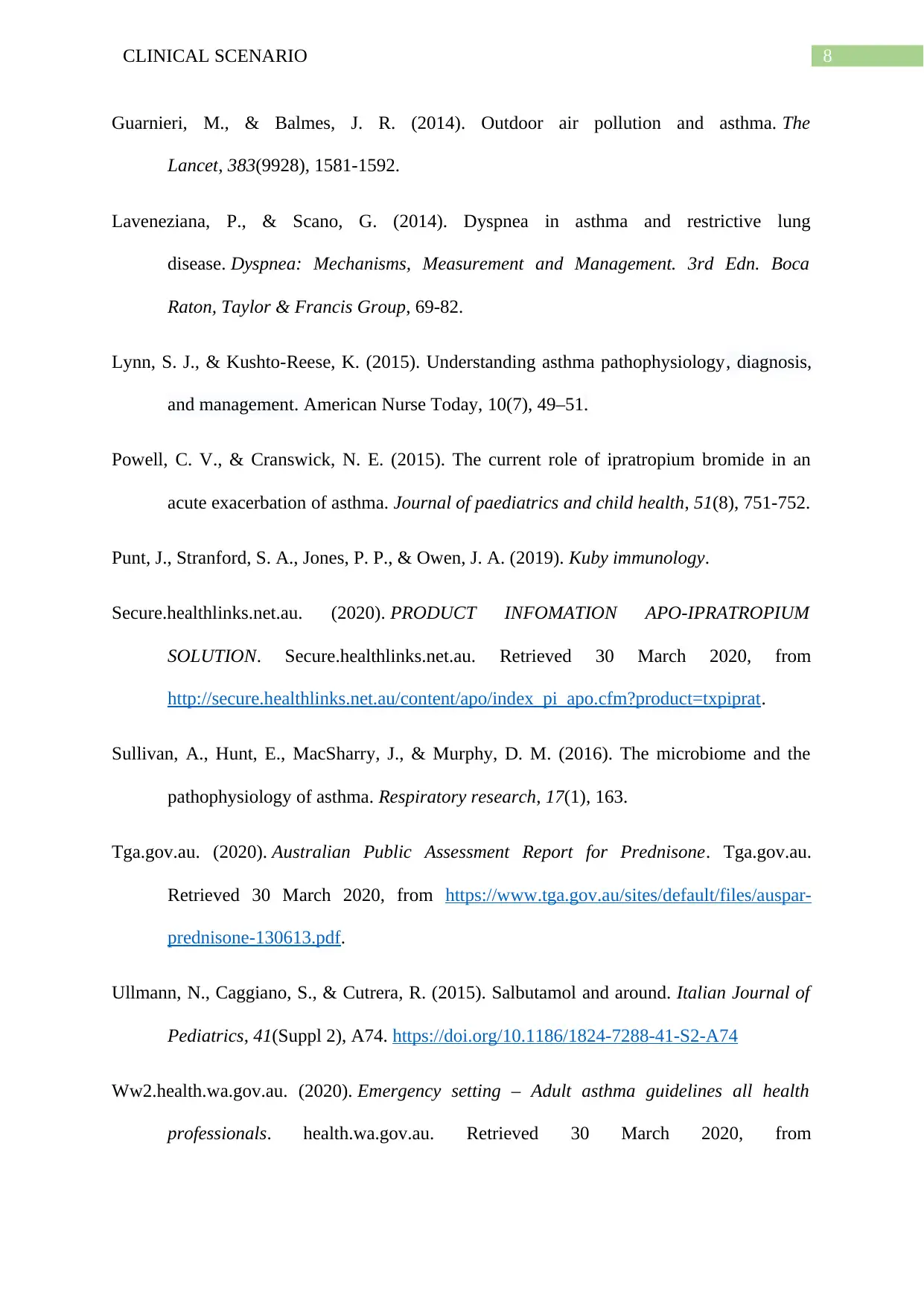
8CLINICAL SCENARIO
Guarnieri, M., & Balmes, J. R. (2014). Outdoor air pollution and asthma. The
Lancet, 383(9928), 1581-1592.
Laveneziana, P., & Scano, G. (2014). Dyspnea in asthma and restrictive lung
disease. Dyspnea: Mechanisms, Measurement and Management. 3rd Edn. Boca
Raton, Taylor & Francis Group, 69-82.
Lynn, S. J., & Kushto-Reese, K. (2015). Understanding asthma pathophysiology, diagnosis,
and management. American Nurse Today, 10(7), 49–51.
Powell, C. V., & Cranswick, N. E. (2015). The current role of ipratropium bromide in an
acute exacerbation of asthma. Journal of paediatrics and child health, 51(8), 751-752.
Punt, J., Stranford, S. A., Jones, P. P., & Owen, J. A. (2019). Kuby immunology.
Secure.healthlinks.net.au. (2020). PRODUCT INFOMATION APO-IPRATROPIUM
SOLUTION. Secure.healthlinks.net.au. Retrieved 30 March 2020, from
http://secure.healthlinks.net.au/content/apo/index_pi_apo.cfm?product=txpiprat.
Sullivan, A., Hunt, E., MacSharry, J., & Murphy, D. M. (2016). The microbiome and the
pathophysiology of asthma. Respiratory research, 17(1), 163.
Tga.gov.au. (2020). Australian Public Assessment Report for Prednisone. Tga.gov.au.
Retrieved 30 March 2020, from https://www.tga.gov.au/sites/default/files/auspar-
prednisone-130613.pdf.
Ullmann, N., Caggiano, S., & Cutrera, R. (2015). Salbutamol and around. Italian Journal of
Pediatrics, 41(Suppl 2), A74. https://doi.org/10.1186/1824-7288-41-S2-A74
Ww2.health.wa.gov.au. (2020). Emergency setting – Adult asthma guidelines all health
professionals. health.wa.gov.au. Retrieved 30 March 2020, from
Guarnieri, M., & Balmes, J. R. (2014). Outdoor air pollution and asthma. The
Lancet, 383(9928), 1581-1592.
Laveneziana, P., & Scano, G. (2014). Dyspnea in asthma and restrictive lung
disease. Dyspnea: Mechanisms, Measurement and Management. 3rd Edn. Boca
Raton, Taylor & Francis Group, 69-82.
Lynn, S. J., & Kushto-Reese, K. (2015). Understanding asthma pathophysiology, diagnosis,
and management. American Nurse Today, 10(7), 49–51.
Powell, C. V., & Cranswick, N. E. (2015). The current role of ipratropium bromide in an
acute exacerbation of asthma. Journal of paediatrics and child health, 51(8), 751-752.
Punt, J., Stranford, S. A., Jones, P. P., & Owen, J. A. (2019). Kuby immunology.
Secure.healthlinks.net.au. (2020). PRODUCT INFOMATION APO-IPRATROPIUM
SOLUTION. Secure.healthlinks.net.au. Retrieved 30 March 2020, from
http://secure.healthlinks.net.au/content/apo/index_pi_apo.cfm?product=txpiprat.
Sullivan, A., Hunt, E., MacSharry, J., & Murphy, D. M. (2016). The microbiome and the
pathophysiology of asthma. Respiratory research, 17(1), 163.
Tga.gov.au. (2020). Australian Public Assessment Report for Prednisone. Tga.gov.au.
Retrieved 30 March 2020, from https://www.tga.gov.au/sites/default/files/auspar-
prednisone-130613.pdf.
Ullmann, N., Caggiano, S., & Cutrera, R. (2015). Salbutamol and around. Italian Journal of
Pediatrics, 41(Suppl 2), A74. https://doi.org/10.1186/1824-7288-41-S2-A74
Ww2.health.wa.gov.au. (2020). Emergency setting – Adult asthma guidelines all health
professionals. health.wa.gov.au. Retrieved 30 March 2020, from

9CLINICAL SCENARIO
https://ww2.health.wa.gov.au/~/media/Files/Corporate/general%20documents/Health
%20Networks/Respiratory/Asthma-Guidelines-for-Adults.pdf.
https://ww2.health.wa.gov.au/~/media/Files/Corporate/general%20documents/Health
%20Networks/Respiratory/Asthma-Guidelines-for-Adults.pdf.
1 out of 10
Related Documents
Your All-in-One AI-Powered Toolkit for Academic Success.
+13062052269
info@desklib.com
Available 24*7 on WhatsApp / Email
![[object Object]](/_next/static/media/star-bottom.7253800d.svg)
Unlock your academic potential
© 2024 | Zucol Services PVT LTD | All rights reserved.





